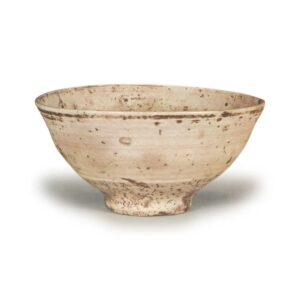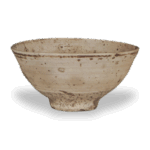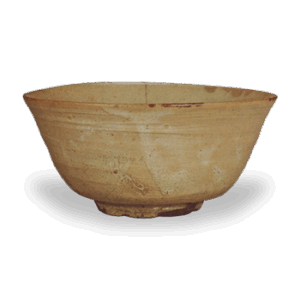



Accessories
Inner box: Paulownia wood, white lacquer finish, with inscription by Kobori Jūzaemon; inner lid with label and inscription by Tsuchiya Sagami-no-kami. Outer box: Paulownia wood, white lacquer finish, with inscription by Matsudaira Iga-no-kami.
Provenance: Arikawa Shinbei → Tsuchiya Sagami-no-kami → Matsudaira Iga-no-kami → Edo Jūnin-shū Kawamura Denzaburō → Umakoshi Kasei.
Recorded in: Kokon Meibutsu Ruishū (Collection of Famous Objects from Ancient and Modern Times), Tsuchiya Zōchō (Tsuchiya Family Account Book), Ōkusa (Old Man’s Grass).
Dimensions
Height: 7.0–7.2 cm Mouth diameter: 14.3–14.19 cm Foot diameter: 5.4 cm Same height: 0.9 cm Weight: 290 g
This tea bowl is named after Arikawa Shinbei, a merchant from Kyoto who is said to have owned it, but it has no specific classification such as “Katen” or “Amemori.” Records about this tea bowl have varied over the years, with some suggesting it resembles a powder-coated tea bowl from the Kaga Maeda family or a tea bowl with a white glaze, while others describe it as a well-shaped tea bowl or a tea bowl used for soba noodles. The uncertainty surrounding its true nature is evident. However, considering its rounded edges, wide foot with bamboo-like patterns, and white translucent glaze primarily made of feldspar, it is almost certain that this piece belongs to the “Kante” or “Amemori” style.
In the case of this tea bowl, however, the clay and glaze have unusually blended well, with no cracks or pits, resulting in almost no signs of rain leakage.
This is likely why it has maintained its snow-white surface, leading it to be mistaken for the work of Chu Hak. Today, it might be referred to as “Yurai Katen.”
Inner box: Paulownia wood, inscription by Kobori Jūzaemon
Outer box (partial) inscription by Matsudaira Iga-no-kami








